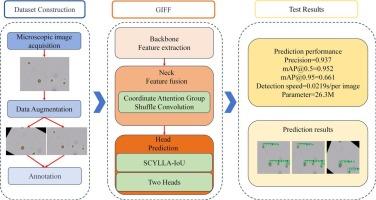GIFF-AlgaeDet:一种基于全局信息和特征融合的高效轻量级微藻检测深度学习方法
IF 4.5
2区 生物学
Q1 BIOTECHNOLOGY & APPLIED MICROBIOLOGY
Algal Research-Biomass Biofuels and Bioproducts
Pub Date : 2024-12-01
DOI:10.1016/j.algal.2024.103815
引用次数: 0
摘要
微藻的鉴定和检测是开发利用微藻资源的必要前提。传统的微藻鉴定检测方法存在准确性差、费时费力等问题。本文提出了一种基于全局信息与特征融合(GIFF)的微藻识别与检测方法。首先,为了解决准确率低的问题,将坐标注意群洗牌卷积(Coordinate Attention Group Shuffle Convolution, CAGS)引入到方法中,增强特征提取能力。此外,为了解决人工耗时的问题,设计了两个用于微藻检测的小型目标检测头,有效提高了训练和检测速度。此外,采用SCYLLA-IoU (SIoU)算法解决了模型收敛不稳定的问题。为了评估本研究中采用的方法的有效性,特意创建了一个用于检测微藻的数据集。实验结果表明,在相同的实验条件下,本文提出的方法在平均精度、mAP@50和mAP@95方面都取得了显著的提高。与原方法相比,分别提高了3.1%、2%和9.8%。此外,该算法在检测速度和亮度方面都有很大的提高,参数减少了29%,单幅图像检测时间为0.0219 s,明显低于基线。数据集和代码的位置:https://github.com/DjtuResearch/Microalgae_detection。本文章由计算机程序翻译,如有差异,请以英文原文为准。

GIFF-AlgaeDet: An effective and lightweight deep learning method based on Global Information and Feature Fusion for microalgae detection
The identification and detection of microalgae are essential prerequisites for the development and utilization of microalgal resources. Traditional methods for the identification and detection of microalgae face the challenges of poor accuracy and time-consuming labor. Here is a method for microalgae identification and detection proposed in this paper, which utilizes Global Information and Feature Fusion (GIFF).
Initially, to address the issue of low accuracy, the Coordinate Attention Group Shuffle Convolution (CAGS) is incorporated into the method to enhance the feature extraction capability. Furthermore, to address the issue of time-consuming labor, two small object detection heads for microalgae detection have been designed to effectively improve the training and detection speed. Additionally, the SCYLLA-IoU (SIoU) algorithm is employed to address the issue of unstable model convergence. To assess the efficacy of the method employed in this study, a dataset was intentionally created for the purpose of detecting microalgae. The experimental results indicate that, under the same experimental conditions, the proposed method has achieved significant improvements in terms of average precision, mAP@50, and mAP@95. Compared to the original method, it has increased by 3.1 %, 2 %, and 9.8 %, respectively. Moreover, this algorithm obtains a great improvement in detection speed and lightness, with a 29 % reduction in parameters and a single image detection time of 0.0219 s, which is significantly less than baseline. Location of the dataset and code: https://github.com/DjtuResearch/Microalgae_detection.
求助全文
通过发布文献求助,成功后即可免费获取论文全文。
去求助
来源期刊

Algal Research-Biomass Biofuels and Bioproducts
BIOTECHNOLOGY & APPLIED MICROBIOLOGY-
CiteScore
9.40
自引率
7.80%
发文量
332
期刊介绍:
Algal Research is an international phycology journal covering all areas of emerging technologies in algae biology, biomass production, cultivation, harvesting, extraction, bioproducts, biorefinery, engineering, and econometrics. Algae is defined to include cyanobacteria, microalgae, and protists and symbionts of interest in biotechnology. The journal publishes original research and reviews for the following scope: algal biology, including but not exclusive to: phylogeny, biodiversity, molecular traits, metabolic regulation, and genetic engineering, algal cultivation, e.g. phototrophic systems, heterotrophic systems, and mixotrophic systems, algal harvesting and extraction systems, biotechnology to convert algal biomass and components into biofuels and bioproducts, e.g., nutraceuticals, pharmaceuticals, animal feed, plastics, etc. algal products and their economic assessment
 求助内容:
求助内容: 应助结果提醒方式:
应助结果提醒方式:


